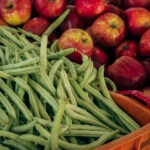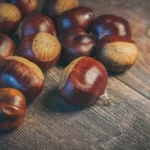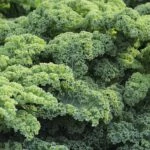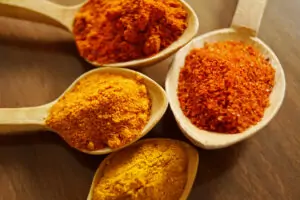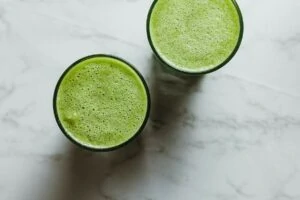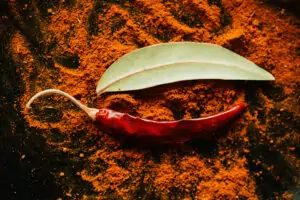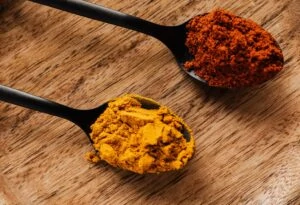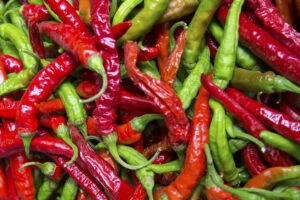As the New Year approaches, I’ve set my mind to a healthier lifestyle, and ginger is one of the spices I’m including in my dishes and drinks. I’ve looked into the history of this spice, some delicious ways to use it in the kitchen, and what health benefits it has to offer my body. Here are the highlights of my discoveries.
What is Ginger?
Ginger is the gnarled, root-like herb sold fresh in most produce sections and in a dry, powdered form in the baking isle. Ginger is a native to Southeast Asia, but has a long cultivation history that has spread throughout Africa and Eurasia. Ginger’s rhizome is harvested, dried and ground into powder, or used whole to flavor ginger ale and other beverages, sauces, breads, curries, pickled foods, and confections.
While the underground portion of the ginger plant where most of its flavor is housed is commonly known as the root, the term is technically incorrect. The root-looking portion of a ginger plant is actually part of the above-ground stem, but it is called a rhizome because it grows horizontally and underground.
Common Varieties of Ginger
Ginger comes in many varieties, and the one common in grocery stores is Zingiber officinale. There are many other types of ginger that are used ornamentally, culinarily, or both. While not many varieties of ginger are known to be poisonous, it is wise to stick with known edible species of ginger in the kitchen.
The part of the ginger plant that is good to eat depends on the plant’s variety. Here are some examples of edible varieties and their useful parts:
- Butterfly ginger (Hedychium coronarium) is reportedly not very delicious, but in the past its young buds and flowers were steamed and eaten or used as a flavoring when better options weren’t available due to food shortages. The roots are edible too once they’re cooked.
- Cardamom ginger (Alpinia calcarata) is not a true ginger, but it has edible leaves and is a popular ginger-like market item in Florida.
- Shell ginger (Alpinia zerumbet) has edible leaves that are used to make ginger tea.
- Torch ginger (Etlingera elatior) is grown ornamentally and is also used culinarily in Malaysia for its delicious and gorgeous young flowers.
- Mango ginger (Curcuma amada) holds a toned-down ginger flavor in its roots, sometimes used to spice pickles.
What Does Ginger Taste Like?
Ginger is a warming herb with a flavor profile that includes a zesty, citrus piquancy. The gingerol compound is what gives your tongue that gingery, pungent/hot sensation.
Some favorite ginger pairings include honey, oranges, pork, chicken, duck, pumpkin and winter squashes, sushi, ale or beer, and curries or chutneys that include similar sweet and spicy herbs. Some spice pairings include cardamom, turmeric, cinnamon, and galangal.
The taste of ginger differs depending on the root’s maturity. The younger the root is, the less pungent and fibrous it is. Baby ginger root is the freshest form of ginger spice, and is often found in the market with the stalks still attached.
I choose not to call ginger hot because, though many ginger flavor profilers use it, the term tends to call on the burning sensation that comes from capsaicin, like the punch packed in chili peppers and aji. Ginger just has its own thing going on!
Is Ginger Good for You?
Ginger’s many health benefits trace back to the 1500s in China, India, and Japan. The benefits of ginger range from providing relief for nausea associated with pregnancy and chemotherapy, to even helping fight cancer, Alzheimer’s disease, and build a strong immune system.
Where to Buy Ginger
Fresh ginger is found in the produce section of most grocery stores, and ground ginger is often sold in small jars in the spice or baking section. Crystalized ginger may be in the baking section or with bulk foods, and pickled ginger can be found with other preserved gingers in your grocery store’s specialty section or in an Asian market.
A broad selection of ginger-flavored candy and other preserved culinary gingers, as well as medicinal forms of ginger are available online, like my favorite chewy ginger candy for long study stints, super gingery tea, and of course your traditional ground ginger, and delicious pickled ginger for sushi night.
If you’re looking for fresh ginger, you know you’ve found a quality fresh ginger root when it smells spicy and bright, and feels heavy, firm and plump, not withered or soft. Look for mold on the root’s ends.
How to Store Ginger
Ginger stores best in cold, dark places. The best way to preserve a whole ginger root is to store it in an airtight container and in the fridge for up to three weeks, or in the freezer for many months.
If you want to grow your own ginger root and harvest it, plant an organic root in a pot in your windowsill. You can dig it up to cut off the end to use in your recipe.
For best planting results, a piece of ginger with buds, or “eyes,” should be soaked in room-temperature water for eight hours or over night. Plant the budding piece in well-draining soil in a shallow, wide pot. Organic ginger is best because sometimes ginger has been treated with chemicals that prevent it from sprouting.
Harvest your kitchen ginger when you see its shoot has appeared, about three to eight weeks after planting. Without completely uprooting your plant, cut a piece off the end of a plump rhizome to use in your cooking. Be sure to recover the the cut end of your ginger plant with soil when you’re finished.
Peeled and cut fresh ginger should be patted dry and stored in an airtight container in the freezer. Cut, frozen ginger makes for easy grating.
Peeled ginger can also be stored in vodka or sherry wine for several weeks to infuse the alcohol with the ginger, or vice versa. Seal the ginger in a glass jar and submerge the ginger completely with alcohol. Cloudy alcohol is a sign of bacteria growth, so toss the ginger and alcohol if you suspect it has gone bad.
Dried, ground, and candied ginger should be stored in a cool, dry, and airtight container to achieve the longest shelf life.
Preserved and pickled ginger should be stored in their original containers in the fridge.
What is a Substitute for Ginger?
- Allspice is a dry spice that kindly replaces ginger with its mild sweet-and-spicy flavor. Replace one tablespoon of fresh ginger with 1/4 teaspoon of ground allspice, or equal parts for ground ginger.
- Cinnamon’s warmth is similar to that of ginger. Substitute ground ginger with an equal amount of ground cinnamon, or substitute one tablespoon of fresh ginger with 1/4 teaspoon or a two-inch stick of cinnamon.
- Nutmeg has a spicy sweetness that mimics ginger well. Replace one tablespoon of fresh ginger with 1/4 teaspoon of ground nutmeg, or equal parts for ground ginger.
- Mace’s warm pepperiness matches ginger beautifully. Replace one tablespoon of fresh ginger with 1/4 teaspoon of ground mace, or equal parts for ground ginger.
- Turmeric is closely related to ginger and its sharp spiciness can step in if you don’t have ginger. Swap ground turmeric for ground ginger in equal parts. Remember that turmeric will give your recipe a yellow color!
- Cardamom, another close family member to ginger, offers a nutty, citrusy flavor that can fill in the lack of ginger. Replace ground cardamom for ground ginger in equal parts.
- Galangal’s flavor profile lands between ginger and turmeric. Since it isn’t as pungent as ginger, it can be used generously as a replacement. One to 1 1/4 tablespoons grated or minced galangal can substitute one tablespoon of ginger, or in equal parts for fresh ginger.
Best Ways to Cook with Ginger
In the West, ginger is used mostly for its sweetness. Pastries, ginger ale, gingersnaps, gingerbread, and ginger cakes show off ginger’s sweet side. Asian and Mediterranean cuisines tend to play on ginger’s spiciness and sourness by using the spice in curries, with meat, and in seafood.
Add ground, or powdered ginger to apple and pumpkin pies. Ground ginger is a must-have spice cupboard staple and an easy way to give a recipe that bright, warm flavor without the need to chop, grate, or peel.
Use fresh ginger by removing the thin, outer skin with a paring knife, or just leave the skin on–it isn’t necessary to remove it. You can slice, chop, grate, or julienne the ginger whether it is peeled or not.
Preserved or candied (also known as crystallized) ginger is made by cooking the rhizome in sugar water and coating it in sugar, and is often used as a garnish or as an ingredient in desserts.
Some recipes call for a “thumb” of ginger. That usually means a piece of fresh ginger about 5 centimeters (2 inches) long, and 1.5 centimeters (0.6 inches) in diameter.
Since ginger measurements come in a large range, I’ve included some conversions and substitutions to use depending on what you have available and what form of measurement you prefer.
- A 1-inch piece of fresh ginger equals about 1 US tablespoon or .26 ounces of grated or chopped ginger.
- A 4-inch, or 1 ounce (28.3 grams) piece of fresh ginger is about 1/4 cup sliced.
Grated or chopped fresh ginger:
- One US tablespoon of grated or chopped fresh ginger equals 6.06 grams.
- One US teaspoon of grated or chopped fresh ginger equals 2.02 grams.
- One US tablespoon of ground/powdered ginger equals 8.43 grams.
- One US teaspoon of ground/powdered ginger equals 2.81 grams.
Ginger form substitutions:
- For every 1 tablespoon of fresh ginger, substitute 1/4 teaspoon of ground/powdered ginger.
- Replace 1 teaspoon of ground/powdered ginger with 1/2 cup of minced candied/crystalized ginger.


